Warehouse Receipt
A warehouse receipt is a document that provides proof of ownership of commodities (such as grains, metals, or goods) that are stored in a warehouse for safekeeping. Warehouse receipts may be negotiable or non-negotiable.
- Negotiable Warehouse Receipt: This type of receipt can be transferred by endorsement and delivery, essentially allowing the title of the stored goods to be transferred from one party to another. The person who holds the negotiable warehouse receipt effectively has ownership of the goods, and he/she can collect them upon presentation of the receipt or sell them by endorsing the receipt to another party.
- Non-negotiable Warehouse Receipt: This type of receipt specifies that the goods are only deliverable to a particular individual or company and cannot be transferred to anyone else by endorsement.
Key Information on a Warehouse Receipt:
A warehouse receipt typically contains the following information:
- Name and address of the warehouse
- The date the receipt was issued
- A unique identification number for the receipt
- Description of the goods (including quantity, type, and condition)
- Location within the warehouse where the goods are stored
- Terms and conditions, including storage fees and the warehouse’s liability for loss or damage
- Signature or digital verification from a warehouse official
Importance:
Warehouse receipts serve several important functions:
- Proof of Ownership: They serve as legal evidence of ownership of goods.
- Facilitate Trade: Negotiable warehouse receipts can be used to facilitate trading and financing activities.
- Risk Management: Storing goods in a reputable warehouse under a warehouse receipt can reduce the risk of loss due to theft or environmental conditions.
- Enable Financing: Businesses can use warehouse receipts to obtain loans, using the stored goods as collateral.
Example of a Warehouse Receipt
Let’s delve into a simplified example featuring a fictional cocoa farmer named Sarah and a warehouse company known as “SafeStore Warehouse.”
Sarah is a cocoa farmer who has just harvested 10 tons of cocoa beans. She wants to store them in a warehouse to ensure their quality is maintained while she looks for buyers. Sarah chooses to use SafeStore Warehouse for storing her cocoa beans.
The Warehouse Receipt:
After Sarah delivers the cocoa beans to SafeStore, she receives a warehouse receipt that contains the following information:
- Warehouse Details: Name and address of SafeStore Warehouse
- Date: September 15, 2023
- Unique ID: Receipt No. 56789
- Description of Goods: 10 tons of cocoa beans
- Location in Warehouse: Aisle 4, Bin 7
- Condition of Goods: Dry and in good condition
- Storage Fees: $20 per ton per month
- Terms and Conditions: Details about SafeStore’s liability and the conditions under which the cocoa beans will be stored
- Signature: Signed by the authorized representative of SafeStore
This receipt is negotiable, meaning Sarah can transfer ownership of the stored cocoa beans to another party if she wishes to.
Scenario 1: Sarah Sells the Cocoa Beans
Sarah finds a buyer named Bob who is willing to purchase all 10 tons of her cocoa beans. Because she has a negotiable warehouse receipt, she can endorse it over to Bob, who then becomes the legal owner of the stored cocoa beans. Bob can present the endorsed warehouse receipt to SafeStore Warehouse and collect the cocoa beans.
Scenario 2: Sarah Uses the Cocoa Beans as Collateral for a Loan
Sarah decides that she needs a loan to expand her farm. She goes to a bank and uses the warehouse receipt as collateral to secure a loan. The bank agrees because the receipt serves as proof of ownership and the stored cocoa beans have value.
Scenario 3: Sarah Simply Collects the Cocoa Beans Later
If Sarah doesn’t sell the cocoa beans or use them as collateral, she can simply present the warehouse receipt to SafeStore Warehouse at a later date to retrieve her stored cocoa beans. She will also pay any storage fees as per the terms in the warehouse receipt.
Conclusion:
In this example, the warehouse receipt serves multiple purposes. It’s a proof of ownership for Sarah, facilitates potential sales transactions without requiring movement of the goods, and can also act as a form of collateral for a loan. This demonstrates the flexibility and utility that warehouse receipts offer in the real world.













